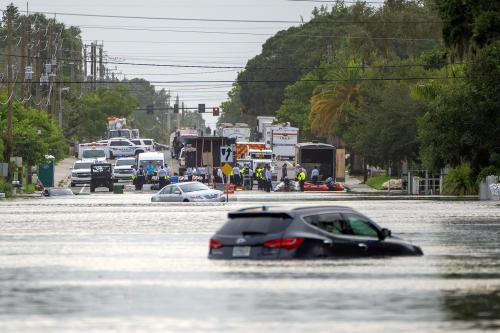The vast plenary hall was nearly empty. Nation after nation had ministers and negotiators stand up for their three minute statements on the progress of these 18th annual climate negotiations taking place in the cavernous Qatar National Convention Center in the desert near Doha. Slim and greying American lead negotiator Todd Stern mounted the steps to deliver what everyone assumed would be a defensive and rote portrayal of an administration doing all it could, the tired and totally debunked line about how the U.S. is showing leadership on climate action.
But he didn’t. Stern summarized the state of the first of four years of talks on the “Durban Platform for Enhanced Action,” which is supposed to negotiate a long-term treaty by 2015, and then went on to surprise nearly everyone. Stern said, “Let’s provide a thorough opportunity for Parties to discuss all critical issues, including the principle of equity and common but differentiated responsibilities and respective capabilities. The United States would welcome such a discussion.” He continued by explaining his logic, “because unless we can find common ground on that principle and the way in which it should apply in the world of the 2020s, we won’t succeed in producing a new Durban Platform agreement. And we have to succeed. So let’s have that discussion.”
Hallelujah. Stern is dead right on this: the past 20 years of negotiations since the initial 1992 Rio de Janeiro Framework Convention on Climate Change has been largely futile because there was no clarity and agreement upfront about the operational meaning of its core principle: “Common but Differentiated Responsibilities and Respective Capabilities.” The phrase is referred to so often in these wonky circles that it is simply called CBRD, or more precisely, CBRD+RC.
The problem is that different countries and individuals have had different ideas about what CBRD means. Admitting “common” responsibilities was an acknowledgement by developing countries that climate change was not just a problem caused by the world’s rich countries and for which they were solely responsible for fixing. This was actually a major concession on their part, since back at that time, the vast majority of the problem had been caused by the developed nations.
The compromise was that countries’ responsibilities were described as “differentiated,” because some countries were far more responsible than others. But how do you properly differentiate between nations? Some major developing nations, including India and China, held that systems of accounting for who was responsible should be based on “per capita” emissions rights, which would allow them substantial room to grow but would require developed nations to cut back substantially, and first. Brazil went one large step further, demanding that richer nations had an “historical responsibility” for the carbon they had put into the atmosphere while getting rich. This approach gave developing nations much more time to grow, and made it even more pressing for developed nations to move quickly.
The developing nations’ preferred approaches were abruptly pushed off the table in the December 1997 Kyoto negotiations, when the protocol adopted just marginal reductions by the wealthy big polluters. No scheme based on any sort of equity principle underlay its purely political solution.
The Kyoto Protocol was never meant to be truly adequate to the task of solving climate change by itself: it was meant to be a first step, in which the wealthy nations would move first in what was called the “First Commitment Period.” A fateful July 1997 resolution by the U.S. Senate tied the Clinton-Gore administration’s hands, saying they could not bring home a treaty that did not include binding limits on developing nations “in the same commitment period.”
Under Kyoto there were just two groups of nations: “Annex 1” nations who took on the marginal binding emissions reductions averaging 8 percent by 2012, and “Non Annex 1” nations who would only take them on at a later date, after the wealthy nations with more responsibility and capability did so first. The Durban Platform, in contrast, says that all countries will take actions to reduce their emissions, which will have several degrees of differentiation. We don’t know yet what those will be—the next three years of negotiations will determine this—but one can assume there will be far different expectations for the impoverished least developed countries than for the OECD or the rapidly industrializing developing nations like China and Brazil. Some very thorny ground will have to be traversed, and there will need to be trust and some basic agreement about what can fairly be asked of each group of countries.
This bind of who will have to act when, and how drastically they’ll have to cut their emissions, has tied us up for these 15 years. This is where the equity issue rears its head again and again each year, and Doha was no exception. For example, in a side event with India’s lead negotiator, leading Indian environmentalist Sunita Narain described how ‘the world is running out of [atmospheric] space and time” before all the capacity of the climate to absorb more carbon will be used up. She refuted the idea that a deal could be made based only on the remaining atmospheric space. “We cannot have ambition without equity: this is the prerequisite for effective action.”
Bashing the U.S. for “fiddling with the numbers” by choosing its own baselines from which to judge its emissions reductions, Narain pushed her Joint Secretary and lead negotiator for India Rajni Ranjan Rashmi hard to demand equity measures be at the core of a new Durban Platform 2015 agreement, and that the Kyoto Protocol be kept going into an effective Second Commitment Period. If equity is watered down more in the Durban Platform text, she said, then India should walk out.
Joint Secretary and lead negotiator for India Rashmi pushed back: “Negotiations are about what is possible, about a balance of ideas.” Just last year at this time in South Africa, India was in the global hot seat, seen as the one major nation blocking the finalization of the Durban Platform because it did not want poorer nations to have to take on emissions reductions. China seemed to be willing to discuss future targets that included reductions. Narain was not the only one making heavy threats: other groups considered pulling out of talks in Doha, and in the final night of negotiations there was, a rumor circulating about Todd Stern saying he would block a controversial element of the text on loss and damage.
It is tempting to frame this story as two dinosaurs arguing for another year as Rome burns – geopolitical rivals battling as the planet heats to dangerous levels. And doing so is probably more smugly satisfying for writer and reader alike. But the story has much more nuance, and frankly it is not getting us where we need to go. We need a more subtle story about opponents and deescalation on all sides to get us to action that is adequate to this daunting task, now, in a way that does not make countries on either side feel cheated.
There is nuance to report, such as when Narain admits that “we all must do our fair share,” and when Stern admits that “we have to succeed…so let’s have that discussion” about equity. These to me are the sounds of two old rivals circling the table before sitting down to find a compromise. A serious one year work program on equity would be an excellent way to have that discussion before it’s too late for it to lay the foundation for the 2015 Durban Platform outcome. Todd Stern did not rule that out when I asked about it in the final week at Doha.
And this old story of battling dinosaurs is crowding out other stories of new green shoots sprouting in the deserts of Doha that need to be told more desperately. The greenest shoots I saw in the deserts of Qatar were from a new negotiating bloc of developing countries who scarcely got mentioned in the media and NGO portrayal of conflict between the old titans, and among the emotive stories of the sinking small island developing states, the radical Latin American left, or the least developed countries. This is a new “revolt of the middle,” a new group of developing countries willing to break from the Group of 77 and China bloc and step up with real ambition, without waiting for emissions reductions or financial support from laggards like the U.S. Meanwhile, having failed to lead or follow, it’s time for the dinosaurs to get out of the way.
The Brookings Institution is committed to quality, independence, and impact.
We are supported by a diverse array of funders. In line with our values and policies, each Brookings publication represents the sole views of its author(s).


Commentary
Doha Climate Change Negotiations: Moving Beyond the Dueling Dinosaurs to Bring Together Equity and Ambition
December 11, 2012